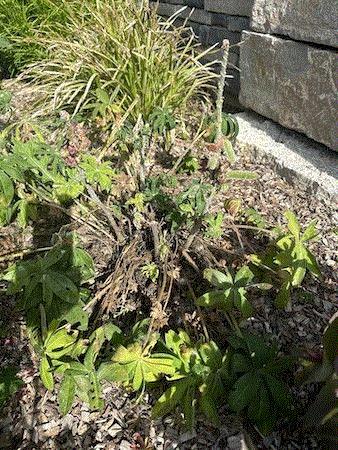What’s Happening Here?
It’s time to put those thinking caps on!
I stumbled across an interesting finding when strolling through the perennial gardens this past weekend. It was enjoyable and rewarding ... until I looked down at a lupine and my heart dropped. Check it out:
That poor plant. I think you’d agree something is very off here. In hindsight, I shouldn’t have been surprised, but this caught me totally off guard. Perhaps you’ve seen this before or can already tell from the image what is going wrong.
Unfortunately, I’m afraid if I provide any clues, it would totally give it away or at the very list take all the fun out of the challenge. Therefore, it’s time for me to ask, “What’s happening here?”
Enjoy the newsletter and I’ll reveal the answer before signing off for the week.
Two Big Shows
In the past couple of issues I covered many great trade events taking place in June and July. Here’s just a brief reminder of two upcoming events I find to be extremely beneficial to the industry.
Cultivate’24
I think everyone would agree that Cultivate, hosted by our national trade association, AmericanHort, is the most significant event for the greenhouse and nursery industry in the U.S. There are more than 150 educational opportunities, eight acres of trade show, some 10,000 of our peers in attendance and tons of networking opportunities.
WHEN: July 13-16, 2024
WHERE: Greater Columbus Convention Center, Columbus, Ohio
Go
HERE to learn more about Cultivate’24.
PPA National Symposium
The PPA National Symposium is undoubtedly the most significant event for the North American perennials industry. It’s packed with tours, education and networking among hundreds of perennial enthusiasts.
WHEN: July 29-August 1, 2024
WHERE: Asheville, North Carolina
Here are links to the two previous newsletters if you’d like a recap some other great events taking place this summer.

Gathering Nuggets
Rather than dreading trade events and thinking of them as unnecessary evils, I find them to be quite the opposite. Trade events are absolutely beneficial and filled with opportunities. I feel that if I come home with just one nugget from a trade event, it was well worth the time and cost to attend. I look at it this way: just one take-home message might enable me to fix a problem, improve a crop, prevent a loss, increase customer interest, become more efficient, cut my costs or improve my profits. Think about that for a moment ... that's great payback!
However, even though a single idea would more than pay for the event, I don't stop there. My aim is to bring home numerous nuggets or ideas I can implement either immediately or over time to improve the crops and/or the business.
Unfortunately, gathering nuggets doesn't just happen on its own. You have to get out there with an open mind, some ambition and a solid plan. Below are two articles I’ve shared in the past that can help you to get the most out of trade events:
Maximizing Trade Events
Trade shows are excellent opportunities to learn, network and for planning or getting motivated for the upcoming growing and sales seasons. Greenhouse and nursery professionals attend trade events for a variety of reasons. Whether you're looking for new plants or equipment, hoping to gain marketing ideas, learning new production techniques at the educational sessions, or networking with customers or industry peers, there's only a finite amount of time to maximize your experience at each of these events.
I've found it beneficial to have a game plan before stepping foot into the venue. First, decide what it is you want to achieve. Your goals could be finding how to correct past production issues, discovering the next hot new crop, how to improve your retail presence or many other possibilities.
Try to get your hands on the events directory or map of the trade show floor and start planning and prioritizing. Determine which educational events you're going to attend; somehow prioritize them using a simple system, such as "must see" or "would like to attend." I recommend taking the same approach with the trade show exhibitors—determine whom do you "have to visit" and whom you’d "like to visit."
You’ll quickly learn that there will be time conflicts that keep you from doing everything you would like to do. If you’re by yourself, you'll have to put some thought into how to maximize your time. If you’re attending with coworkers, divide and conquer. Hit the priority sessions or exhibitors first. Once you've accomplished that list, move on to the secondary priorities. If you complete both of your priority lists, then feel free to walk the trade show or attend more educational sessions at your leisure.

Trade Show Pointers
Here's the second article I've shared in the past. These tips have served me well over the years when walking trade show floors.
-
Schedule some of your “must see” meetings in advance. Don’t leave it to chance that the individual(s) you need to see will be available when you arrive at their booth.
-
Many trade events have apps that are useful in helping you to know when things are happening, how to find them, and often include trade show maps and planners to help you manage your time at the event. Download it!
-
Some of the trade events are really large, so bring comfortable shoes.
-
Only pick up or accept literature that you need and intend to use. Picking up every piece of literature isn't necessary and can be heavy to lug around for hours. I've had good intentions so many times when collecting information. However, more often than not, I find the literature sitting in the trade show bags many months and even years later. Be selective in what you choose to take with you.

-
Don't be intimidated or afraid of approaching the salespeople working the booths at the trade show. Introduce yourself, and when someone approaches you, compliment their booth or their product(s). Then ask specific questions, such as "How does your product work?" or "What’s new?"
-
Bring lots of business cards and take them everywhere you go. You can meet an important contact anywhere—the elevator, hotel, lobby, restaurants, the bar. You never know, so be prepared.
-
If you don't already have a contact person with the company you have an interest in, be sure to get a business card. It's not enough to only give someone your contact information.
-
Follow up. About a week after the trade show, follow up with the companies you intend to work with. Following up is key to successfully maximizing your new contacts. And remember: In this day and age, relationships are everything!
Approach these events with both a solid plan of what you intend to get out of the show and an open mind. In most cases, you’ll discover useful nuggets in places you never expected to find them.

Terra Nova’s Newest Nepetas
The folks at Terra Nova have done it again. They have a knack for introducing potentially game-changing perennials to the industry. In this case, they have two incredible new nepeta introductions. Check them out!
Nepeta Blue Dragon
The first new nepeta I'd like to share with you is Blue Dragon. Unlike most nepeta on the market today, Blue Dragon is a different species, Nepeta yunnanensis. This species isn’t new to the trade, but Terra Nova’s spin on this old classic offers many notable improvements. Compared to the species, Blue Dragon has a sturdier upright habit (rather than floppy), has huge, showier blue flowers (which, upon closer inspection, actually resemble blue dragon heads) and it blooms continuously throughout the entire summer. It reaches 30 to 36 inches tall and wide and is cold hardy to Zone 5.
Nepeta Purple Haze
Purple Haze is a long blooming, compact, mat-forming hybrid nepeta that’ll blow your socks off ... and tickle your toes! Well maybe not, but it will grab your attention. Purple Haze forms low-growing 4-7-in. tall silver mats loaded with purple-blue flower spikes resembling those of buddleias throughout the entire summer. It's hardy to Zone 6 and can even be grown and marketed as a hanging basket as shown above.

The Answer Is...

I shared this image of a problem I observed on a lupine in my landscape at the top of this newsletter and asked if you could determine what was going on. Do you think this appearance is being caused by diseases, insects, an act of God or is something else causing it? Still on the fence? I think this next image will clear it up:
I hope you had an “aha” moment and can clearly see what’s making this lupine look so bad. That’s right, this lupine is being attacked by hundreds of aphids. These aren’t just any aphids, they are lupin aphids (Macrosiphum albifrons).
There are only a few types of aphids that feed on lupines, but lupin aphids are real specialists. They are similar to other types of aphids in their general biology and life cycle (reproducing asexually and giving live births), but they have a distinct difference that gives them an edge on lupine that other types of aphids don’t have. As lupin aphids suck fluids from lupines, they absorb the alkaloids from the plant, which makes them unpalatable (perhaps even toxic) to the other insect species that would normally act as aphid predators. For example, ladybird beetles do not eat lupin aphids.
Controlling lupin aphids is straightforward and simple in the landscape before the plants flower; however, controlling aphids on plants in bloom when pollinators are present becomes more challenging. I’ve found spraying plants with soapy water (Dawn dish soap is my favorite brand) works really well. Natural plant oils, horticultural oils and insecticidal soaps are all quite effective at controlling aphids. Natural pyrethrums and synthetic pyrethroids are also very good at controlling this pest.
As I alluded to above, care should be taken to avoid applying insecticides when pollinators are busy working. Read product labels, avoid making applications to plants in flower, and consider making targeted applications to just the stems and leaves (avoiding applications to flowers) when lupines are blooming.




Thanks for reading this edition of Perennial Pulse. My email is paul@opelgrowers.com if you have any comments, article suggestions or if you'd just like to say hello.
Best regards,

Paul Pilon
Editor-at-Large—Perennial Pulse
Director of Growing—Opel Growers
This email was received by you and 34,559 other fine subscribers!
If you're interested in advertising in Perennial Pulse, contact Kim Brown ASAP and she'll hook you up.